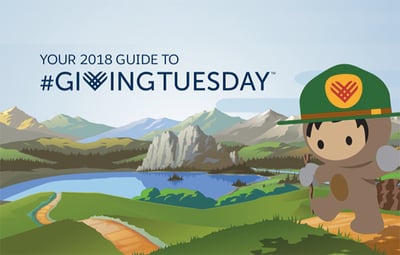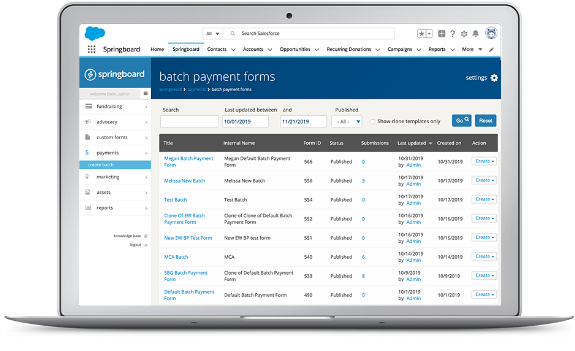3 Trends from 3 Years of #GivingTuesday
 This post originally appeared on the Salesforce.org blog as part of the #GivingTuesday Toolkit.
This post originally appeared on the Salesforce.org blog as part of the #GivingTuesday Toolkit.
On November 27, 2018, the #GivingTuesday movement turns 7. For all 7 years, the team here at Jackson River has been riding shotgun with our clients, seeking to understand how their supporters behave on #GivingTuesday and how it relates to their year-end strategies.
Each January, we ditch the party hats, breathe a post-year end sigh of relief, and settle in with our clients’ campaign data and the official GT outcomes. We scour their #GivingTuesday and end-of-year results for trends, patterns, emergent best practices in fundraising – and we explore what it all might mean.
Over the past three years as #GivingTuesday has matured, we’ve seen a few themes emerge:
1. Donors are taking #GivingTuesday seriously.
You’ve heard this before: #GivingTuesday fundraising totals continue to impress, with $300+ million raised online in 2017, up 78% from 2016. Over the last 3 years, average GT gift amounts have stabilized around $120, which is on par with industry-wide, year-round, single-gift averages of $124.
After the 2016 election, some clients received a massive outpouring of donations, including both their #GivingTuesday and End of Year campaigns. But even accounting for this, our clients’ average one-time GT gift amounts are also holding steady.
This suggests that while donors still often split their #GivingTuesday ducats among several organizations, they’re giving larger totals overall – rather than the token, small-dollar, “chip in-” style donations that characterized the early years of the GT movement.
What this means for you: It’s okay to (tactfully) ask your donors for more on #GivingTuesday, without worrying that you’ll cannibalize your year-end asks. Tactics like offering a match and multiple email sends on the day-of have become GT best practices. We also recommend techniques like dynamic gift strings based on previous giving history and even combining one-time with recurring asks (also known as recurring or monthly donations) in a single campaign.
2. #GivingTuesday + End-of-Year Giving = One Supporter Journey
As we’ve noted before, no ask is ever just a single-day affair. The organizations seeing the best combined results in November and December are treating #GivingTuesday as the launch of their fundraising season – meaning a steady cadence of cultivation, asks, acknowledgements, and most of all, gratitude that spans from October through December.
To be clear, this is not a one-and-done, “make your year-end gift early and we’ll stop hounding you!” approach. Instead, the organizations consistently seeing the best year-end results are offering a thoughtful, unified supporter journey that begins well before GT and lasts beyond the new year. That is: in the months before Giving Tuesday, prepare your strategy, your plan to grow your list, and set up donor thank yous, so everything is ready to go. Once you wrap up your overall strategy, you can create your “ask journey” on Giving Tuesday.
What this means for you: Though nonprofit staff should plan a (very) well-deserved breather between #GivingTuesday and December, your messaging should reflect one continuous, coherent arc (see these #GivingTuesday content strategy tips). Once you’ve joined these two campaigns together, your next step is to create distinct journeys based on donor behavior, such as: 1) a series for existing donors; 2) an orientation journey for new donors that come in on #GivingTuesday; and 3) a treatment for any new sustaining donors you might have attracted. (And yes, it’s possible to build your sustainer base on #GivingTuesday! Which leads us to…)
3. #GivingTuesday can be great for both acquisition and sustainer conversion.
While one-time gifts from existing supporters still constitute the bulk of GT donations (60-80% for our clients), we are seeing #GivingTuesday increasingly become a single-day impetus for supporters to explore new causes and for donors to go deeper with their existing commitments.
Acquisition: The great promise of the #GivingTuesday movement has been to turn Black Friday shoppers into donors, turning philanthropy into an everyday holiday activity can help shift consumers’ thinking about their holiday spending. The data suggests that the movement has succeeded, with greater numbers of donors giving to more diverse causes each year. Across causes and sectors, our clients are seeing an average of 20-40% of #GivingTuesday gifts from new contacts.
Sustainer Conversion: Perhaps more surprisingly, our clients who actively encourage sustaining gifts as part of their #GivingTuesday campaign are seeing 2-7% growth in the number of new sustainers — a small but significant percentage in terms of lifetime value to the organization.
What this means for you: If acquisition is a focus for you this GT (and when isn’t it, really?), look for ways to steward your volunteers, advocates, and other non-financial supporters into becoming cause-knowledgeable donors, as well as community-based ways to connect with potential new supporters leading up to #GivingTuesday. If you have a strong base that regularly gives at year-end, consider tactics like running a single-day sustainer upsell campaign, asking supporters to give more by making a monthly commitment — or even encouraging gift upgrades for existing sustainers.
We’re excited to see what you do this #GivingTuesday!

